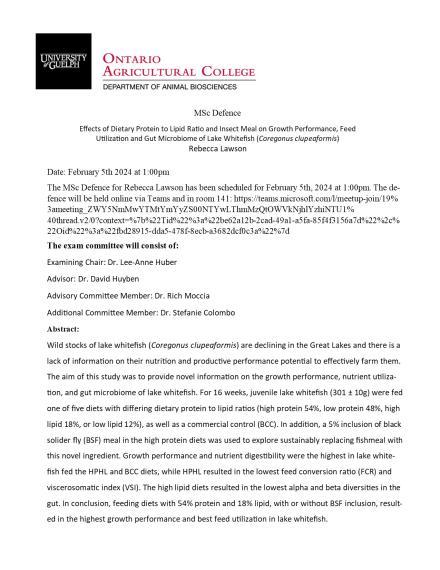Rebecca Lawson's MSc Defence
Date and Time
Location
Room 141 and Teams: https://teams.microsoft.com/l/meetup-join/19%3ameeting_ZWY5NmMwYTMtYmYyZS00NTYwLThmMzQtOWVkNjhlYzhiNTU1%40thread.v2/0?context=%7b%22Tid%22%3a%22be62a12b-2cad-49a1-a5fa-85f4f3156a7d%22%2c%22Oid%22%3a%22fbd28915-dda5-478f-8ecb-a3682dcf0c3a%22%7d

Details
Effects of Dietary Protein to Lipid Ratio and Insect Meal on Growth Performance, Feed Utilization and Gut Microbiome of Lake Whitefish (Coregonus clupeaformis)
Wild stocks of lake whitefish (Coregonus clupeaformis) are declining in the Great Lakes and there is a lack of information on their nutrition and productive performance potential to effectively farm them. The aim of this study was to provide novel information on the growth performance, nutrient utilization, and gut microbiome of lake whitefish. For 16 weeks, juvenile lake whitefish (301 ± 10g) were fed one of five diets with differing dietary protein to lipid ratios (high protein 54%, low protein 48%, high lipid 18%, or low lipid 12%), as well as a commercial control (BCC). In addition, a 5% inclusion of black solider fly (BSF) meal in the high protein diets was used to explore sustainably replacing fishmeal with this novel ingredient. Growth performance and nutrient digestibility were the highest in lake whitefish fed the HPHL and BCC diets, while HPHL resulted in the lowest feed conversion ratio (FCR) and viscerosomatic index (VSI). The high lipid diets resulted in the lowest alpha and beta diversities in the gut. In conclusion, feeding diets with 54% protein and 18% lipid, with or without BSF inclusion, resulted in the highest growth performance and best feed utilization in lake whitefish.